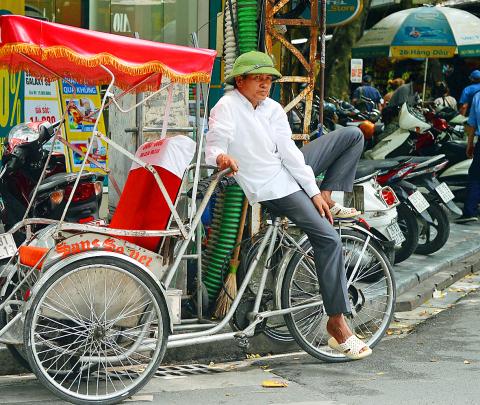For years Nguyen Huu Son has guided Chinese tourists around Vietnam’s popular coastal city Danang, but a bitter maritime dispute between Hanoi and Beijing means he is now out of work.
Relations between the neighbors plunged to their lowest point in decades when Beijing moved a deep-sea oil rig into disputed waters in the South China Sea in early May, triggering deadly riots in Vietnam.
The rig has since been withdrawn, but the Chinese tourists have not returned.

Photo: AFP
“It’s never been this bad before... My company has almost no customers, no work,” Son said.
Son’s salary has been cut by two-thirds, but he feels “embarrassed” to take even this reduced pay package as he knows his company is not making any money at all.
“We focus on individual travelers, not tour groups, and 100 percent of them cancelled... I have nothing to do with my time,” he said, adding that he was mulling a change of career.
After the mid-May riots, in which China says four of its nationals were killed, Beijing evacuated thousands of citizens and issued a “yellow” travel warning for Vietnam.
While this was reasonable in the immediate aftermath of the riots — which mostly affected Taiwanese and South Korean businesses — maintaining the travel warning when any danger to tourists has passed smacks of politics, said Jonathan London at City University of Hong Kong.
“It reminds one of Beijing’s campaign to reduce mainland tourism to the Philippines,” London said, referring the economic fallout from the 2012 standoff over the Scarborough Shoal (Huangyan Island, 黃岩島).
After a dispute over the uninhabited shoal, Beijing warned its citizens about travel safety in the Philippines, prompting mass cancellations of trips.
Chinese tourist arrivals to Vietnam were down 29.5 percent last month from the previous month, according to official figures.
Last month, 136,726 Chinese visited Vietnam, down from 194,018 in May and 216,659 in April this year, the figures show.
Vietnam will continue tourism promotion efforts in China, aiming to show “Vietnam is a safe destination,” said Nguyen Manh Cuong, an official at the tourism department.
Tourism is an important source of revenue for Vietnam, contributing nearly 6 percent of the country’s GDP last year, official statistics show.
Chinese visitors make up the largest single group of arrivals — more than 1.1 million this year overall, despite the sharp fall off after May.
The next largest group, South Korea, saw 405,634 arrivals.
The average Chinese visitor stays five days and spends US$300 if they travel by land, or US$700 if they have arrived by airplane, Cuong said.
That compares with an average stay of about 10 days by European or US tourists, who spend up to US$3,000 during that period, official figures show.
The fall in Chinese arrivals after the maritime dispute erupted is understandable as Beijing uses outbound tourism as a “negative sanction,” according to Tony Tse, a professor at the school of hotel and tourism management at Hong Kong Polytechnic University.
“Outbound tourism can be used by the Chinese government to show its aggression,” he said in a paper last year, citing the examples of the Philippines and Japan — where tourism was hard hit after a 2012 dispute with the latter over the Senkaku Islands, known as the Diaoyu Archipelago (釣魚群島) in China and the Diaoyutai Islands (釣魚台) by Taiwan, which also claims them.
“The hostility in withholding tourism acts like a punishment and China is powerful enough to exercise this kind of sanction,” Tse wrote in the paper on how China uses outbound tourism as a form of diplomacy.
Vietnamese have also been cancelling trips to China in droves, although the government has not issued any travel warning, said one agent who declined to be named.
“It’s a way to express patriotism. Vietnamese like travelling in China ... but now they cancel to show their patriotism,” he said.
Tran Thi Lan, 54, a primary school teacher from central Nghe An Province, had booked a trip to China for this summer which she was “very excited” about.
“We decided to cancel, not the tour operator. The Chinese government’s behavior was unacceptable,” she said.
“We decided not to go to show our attitude... We don’t want to go on holiday to a country that is invading our waters,” she said.

POLITICAL PRISONERS VS DEPORTEES: Venezuela’s prosecutor’s office slammed the call by El Salvador’s leader, accusing him of crimes against humanity Salvadoran President Nayib Bukele on Sunday proposed carrying out a prisoner swap with Venezuela, suggesting he would exchange Venezuelan deportees from the US his government has kept imprisoned for what he called “political prisoners” in Venezuela. In a post on X, directed at Venezuelan President Nicolas Maduro, Bukele listed off a number of family members of high-level opposition figures in Venezuela, journalists and activists detained during the South American government’s electoral crackdown last year. “The only reason they are imprisoned is for having opposed you and your electoral fraud,” he wrote to Maduro. “However, I want to propose a humanitarian agreement that

ECONOMIC WORRIES: The ruling PAP faces voters amid concerns that the city-state faces the possibility of a recession and job losses amid Washington’s tariffs Singapore yesterday finalized contestants for its general election on Saturday next week, with the ruling People’s Action Party (PAP) fielding 32 new candidates in the biggest refresh of the party that has ruled the city-state since independence in 1965. The move follows a pledge by Singaporean Prime Minister Lawrence Wong (黃循財), who took office last year and assumed the PAP leadership, to “bring in new blood, new ideas and new energy” to steer the country of 6 million people. His latest shake-up beats that of predecessors Lee Hsien Loong (李顯龍) and Goh Chok Tong (吳作棟), who replaced 24 and 11 politicians respectively

Young women standing idly around a park in Tokyo’s west suggest that a giant statue of Godzilla is not the only attraction for a record number of foreign tourists. Their faces lit by the cold glow of their phones, the women lining Okubo Park are evidence that sex tourism has developed as a dark flipside to the bustling Kabukicho nightlife district. Increasing numbers of foreign men are flocking to the area after seeing videos on social media. One of the women said that the area near Kabukicho, where Godzilla rumbles and belches smoke atop a cinema, has become a “real

‘WATER WARFARE’: A Pakistani official called India’s suspension of a 65-year-old treaty on the sharing of waters from the Indus River ‘a cowardly, illegal move’ Pakistan yesterday canceled visas for Indian nationals, closed its airspace for all Indian-owned or operated airlines, and suspended all trade with India, including to and from any third country. The retaliatory measures follow India’s decision to suspend visas for Pakistani nationals in the aftermath of a deadly attack by shooters in Kashmir that killed 26 people, mostly tourists. The rare attack on civilians shocked and outraged India and prompted calls for action against their country’s archenemy, Pakistan. New Delhi did not publicly produce evidence connecting the attack to its neighbor, but said it had “cross-border” links to Pakistan. Pakistan denied any connection to